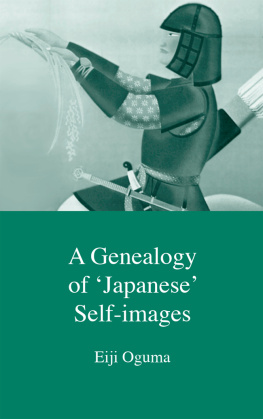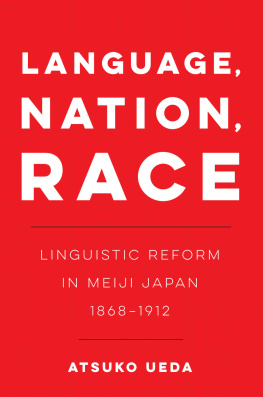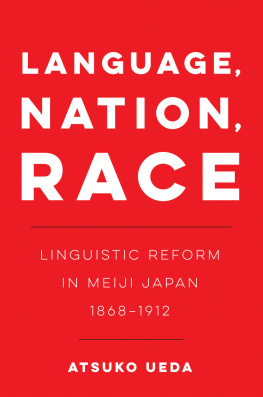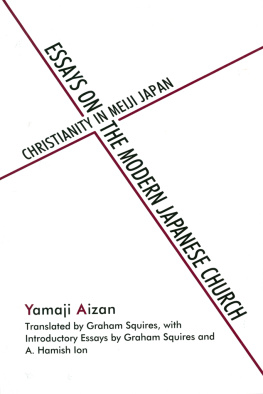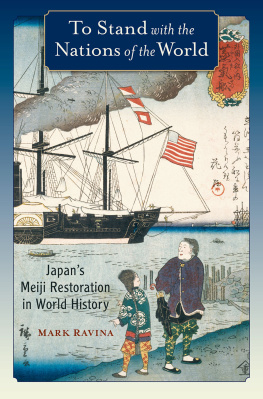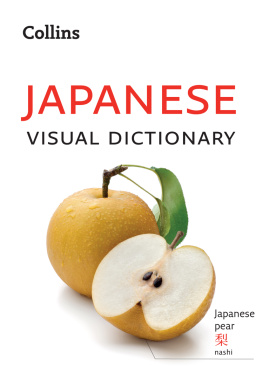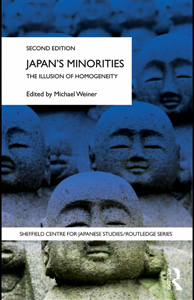A Genealogy
of Japanese
Self-images

JAPANESE SOCIETY SERIES
General Editor: Yoshio Sugimoto
Lives of Young Koreans in Japan
Yasunori Fukuoka
Globalization and Social Change in Contemporary Japan
J.S. Eades Tom Gill Harumi Befu
Coming Out in Japan: The Story of Satoru and Ryuta
Satoru Ito and Ryuta Yanase
Japan and Its Others:
Globalization, Difference and the Critique of Modernity
John Clammer
Hegemony of Homogeneity:
An Anthropological Analysis of Nihonjinron
Harumi Befu
Foreign Migrants in Contemporary Japan
Hiroshi Komai
A Social History of Science and Technology in Contempory Japan, Volume 1
Shigeru Nakayama
Farewell to Nippon: Japanese Lifestyle Migrants in Australia
Machiko Sato
The Peripheral Centre:
Essays on Japanese History and Civilization
Johann P. Arnason
A Genealogy of Japanese Self-images
Eiji Oguma
A Genealogy
of Japanese
Self-images
Eiji Oguma
Translated by David Askew

This English edition first published in 2002 by
Trans Pacific Press, PO Box 164, Balwyn North, Melbourne, VIC 3104, Australia
Telephone: +61 3 9859 1112 Fax +61 3 8611 7989
Email:
Web: http://www.transpacificpress.com
Copyright Trans Pacific Press 2002
Designed and set by Digital Environs, Melbourne.
Printed by BPA Print Group, Burwood, Victoria, Australia
Reprinted 2005, 2014
Distributors
Australia
James Bennett Pty Ltd
Locked Bag 537
Frenchs Forest NSW 2086
Australia
Telephone: +61 2 8988 5000
Fax: +61 2 8988 5031
Email:
Web: www.bennett.com.au
Japan and Asia
Kinokuniya Company Ltd.
38-1 Sakuragaoka 5-chome
Setagaya-ku, Tokyo 156-8691
Japan
Telephone: +81 3 3439 0161
Fax: +81 3 3439 0839
Email:
Web: www.kinokuniya.co.jp
USA and Canada
International Specialized Book
Services (ISBS)
920 NE 58th Avenue, Suite 300
Portland, Oregon 97213-3786
USA
Telephone: (800) 944-6190
Fax: (503) 280-8832
Email:
Web: http://www.isbs.com
All rights reserved. No production of any part of this book may take place without the written permission of Trans Pacific Press.
ISSN 14439670 (Japanese Society Series)
ISBN 1876843837 (Hardback)
ISBN 1876843 047 (Paperback)
ISBN 9781925608236 (eBook)
National Library of Australia Cataloging in Publication Data
Oguma, Eiji, 1962.
A genealogy of Japanese self-images.
Bibliography.
Includes index.
ISBN 1 876843 04 7(pbk.)
ISBN 1 876843 83 7.
1. Ethonology Japan. 2. Japanese Ethnic identity. 3. Japan Ethnic relations. 4. Japan Colonies East Asia. I. Title. (Series : Japanese society series).
305.8956
Contents
Japan, showing principal places mentioned in the text. Broad districts are in large type, prefectures in medium type and cities in small type.

Translators Commentary
I first read the original Japanese version of this book, Tanitsu minzoku shinwa no kigenNihonjin no jigaz no keifu, in late 1995. At the time, I quickly skipped through it, cursed Oguma for his age (born in 1962, he is of my own generation), and filed it away in my mind as an interesting read. It was perhaps two years or so later, when I was asked if I was interested in translating it, that I dug it up again and read it through carefully. After writing a long article on it an article I was later asked to expand by including Ogumas second work, Nihonjin no kykaiOkinawaAinuTaiwanChsen shokuminchi shihai kara fukki und made (The Boundaries of the Japanese: Okinawa, the Ainu, Taiwan and Korea. From Colonial Domination to the Return Movement) (Oguma 1998) and giving the matter far too little thought, I agreed. Although I have some minor quibbles with Oguma, his work is, I thought then and still think now, both interesting and important.
It is interesting because it challenges a major assumption frequently seen in works, both in English and in Japanese, about the Japanese self-image: that the myth of ethnic homogeneity was a product of prewar Japan. This assumption can perhaps be partly explained by the unfortunate habit many Japanese have of viewing the prewar years and in fact the entire history of modern Japan from 1868 to 1945 as a dark age, and thus to tend to believe that all the negative aspects of modern Japanese intellectual life must have their roots in this period. As Oguma also implies, this assumption is also the result of a lack of historical research after all, as this work shows, to read the pre-1945 literature is to realise that the dominant myth of the Great Japanese Empire was not one of ethnic homogeneity. Moreover, it is perhaps a sign of how dramatic the paradigm shift was, from a self-image of the Japanese nation as consisting of a plurality of ethnic groups to one of the Japanese as consisting of a single ethnicity, that this assumption has not previously been challenged. Oguma has, however, exposed it as false, and it is difficult to believe that it could ever be taken seriously again.
This work also argues that the size of the Japan of the day heavily influenced the dominant self-image. As Japan grew with imperial expansion, the notion that the Japanese were the product of a melting pot of many different ethnic groups strengthened but, as Japans borders contracted with military defeat, this notion was replaced with a belief in ethnic homogeneity. Although I have my doubts about this argument, it is without question both interesting and a plausible explanation for the changes in the discourse on the Japanese nation.
The major theme tackled here is the discourse on modern Japanese national identity. This is examined through an analysis of a number of debates in imperial Japan, including those between assimilation and racism, imperialism and national self-determination, nationalism (in the sense of ethnocentricity) and Pan-Asianism, and pure blood and Japanisation. This work examines the location of various minorities within the Japanese intellectual landscape. It encompasses the relationship between the Japanese nation and the ethnic minorities of the empire the burakumin (seen to be an alien people), the Ainu, the peoples of Okinawa, Taiwan, Korea and the South Seas (Japanese Micronesia) and, within the Japanese nation itself, the role and status of women and Christians. A strong sub-text of this work is the process (analysed in further detail in Ogumas second work) by which lines, borders and boundaries are drawn between individuals and groups in establishing self-identity, and the accompanying discourse on acceptance and rejection (or racism, or discrimination).
This book will appeal to readers with an interest in the relationship between empire and national identity, nationalism, and the Japanese orientalist discourse, as well as specialists in modern Japanese history and Japanese colonialism. It examines the discourse on ethnic and other minorities within Japan, and provides an intellectual history of one key concept in modern Japan Japanese national identity. It sheds light on several aspects of the intellectual landscape of postwar Japan, such as the Symbolic Emperor System, and the importance of rice in at least one approach to constructing the Japanese.

